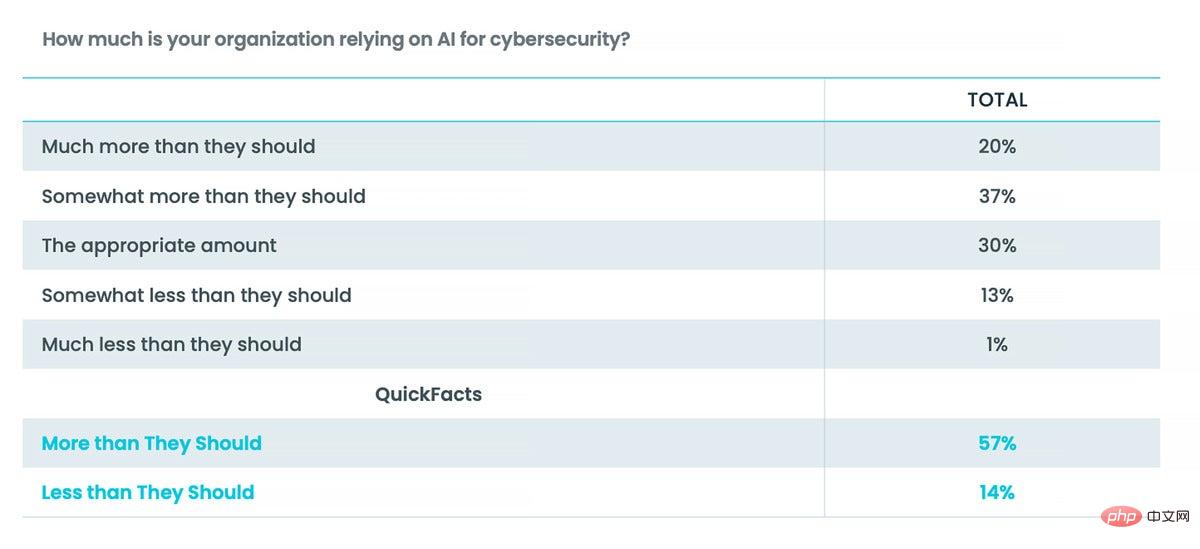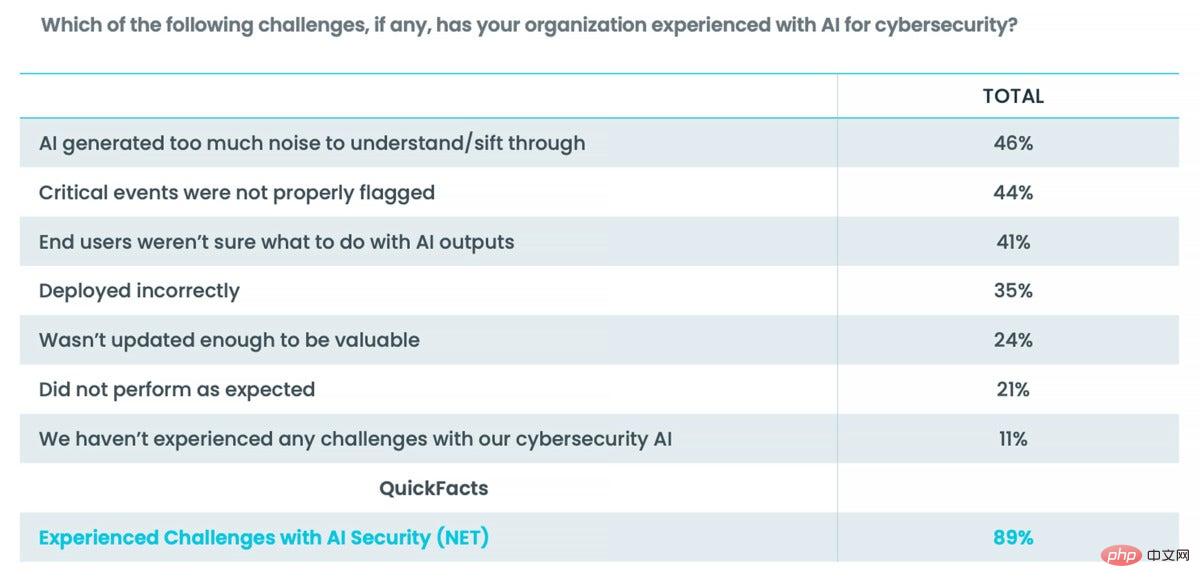 Technology peripherals
Technology peripherals
 AI
AI
 Three major misunderstandings about artificial intelligence in cybersecurity
Three major misunderstandings about artificial intelligence in cybersecurity
Three major misunderstandings about artificial intelligence in cybersecurity

Whether in novels or movies, artificial intelligence has been a fascinating subject for decades. While the synthetic humans envisioned by Philip K. Dick still exist only in science fiction, artificial intelligence is real and is playing an increasing role in many aspects of our lives.
While there are arguments for and against robots with artificial intelligence brains, a more common and equally powerful form of artificial intelligence is starting to play a role in cybersecurity. The goal is to make AI a force multiplier for hard-working security professionals.
As seen in the DevoSOC Performance Report™, security operations center (SOC) analysts are often overwhelmed by the number of alerts that keep popping up on their screens every day. “Vigilance fatigue” has emerged as a cause of analyst burnout across the industry.
Ideally, AI can help SOC analysts keep up with (and stay ahead of) the smart but ruthless threat actors who are effectively using AI to conduct crimes or espionage. But fortunately, this has not happened yet.
Three Big Misconceptions about Artificial Intelligence
Devo commissioned Wakefield Research to conduct a survey of 200 IT security professionals to determine their views on artificial intelligence. The survey covers AI implementation across a range of defense disciplines including threat detection, breach risk prediction and incident response/management.
Artificial Intelligence is considered a force multiplier for cybersecurity teams struggling to keep up with savvy malicious actors, talent shortages, and more. However, not all AI is so intelligent, and that's even before we take into account the mismatch in needs and capabilities.
Myth 1: Intelligence-driven cybersecurity is already here
All survey respondents said their organizations are using artificial intelligence in one or more areas. The most used area is IT asset inventory management, followed by threat detection and breach risk prediction.
But in terms of using AI to directly combat threat actors, it’s not really a battle yet. Some 67% of respondents said their organization’s use of AI “only scratches the surface of the problem.”
Here’s a look at how respondents view their organization’s reliance on artificial intelligence in cybersecurity programs.

More than half of respondents believe their organization – at least for now – is too reliant on artificial intelligence. Less than a third of respondents believe reliance on AI is appropriate, while a minority believe their organizations are not doing enough with AI.
Myth 2: AI will solve security problems
When asked about their views on the challenges posed by the use of AI in their organizations, respondents told it like it was. Only 11% of respondents said they had no problems using AI for cybersecurity. The vast majority of respondents had a very different view.

When asked where AI-related challenges occur within their organization’s security stack, core cybersecurity functions performed poorly. Fifty-three percent of respondents said IT asset inventory management is the top problem area for AI, but responses were also unsatisfactory in three cybersecurity categories:
- Threat detection (33%).
- Understand cybersecurity strengths and gaps (24%).
- Breach risk prediction (23%).
Interestingly, very few respondents (13%) mentioned incident response as a challenge posed by artificial intelligence.
Myth Three: Artificial Intelligence is intelligent, so it must be effective
It is clear that although artificial intelligence is already being used in cybersecurity, the results are mixed. The biggest misconception about AI is that not all AI is as “intelligent” as its name implies, and that’s not even taking into account the mismatch between organizational needs and capabilities.
The cybersecurity industry has long struggled to find “silver bullet” solutions. Artificial intelligence is the latest one. Organizations must be thoughtful and results-driven when evaluating and deploying AI solutions. Organizations must ensure they work with experienced experts in AI technology, or else they will fail in a critical area with little room for error.
The above is the detailed content of Three major misunderstandings about artificial intelligence in cybersecurity. For more information, please follow other related articles on the PHP Chinese website!

Hot AI Tools

Undresser.AI Undress
AI-powered app for creating realistic nude photos

AI Clothes Remover
Online AI tool for removing clothes from photos.

Undress AI Tool
Undress images for free

Clothoff.io
AI clothes remover

AI Hentai Generator
Generate AI Hentai for free.

Hot Article

Hot Tools

Notepad++7.3.1
Easy-to-use and free code editor

SublimeText3 Chinese version
Chinese version, very easy to use

Zend Studio 13.0.1
Powerful PHP integrated development environment

Dreamweaver CS6
Visual web development tools

SublimeText3 Mac version
God-level code editing software (SublimeText3)

Hot Topics
 Bytedance Cutting launches SVIP super membership: 499 yuan for continuous annual subscription, providing a variety of AI functions
Jun 28, 2024 am 03:51 AM
Bytedance Cutting launches SVIP super membership: 499 yuan for continuous annual subscription, providing a variety of AI functions
Jun 28, 2024 am 03:51 AM
This site reported on June 27 that Jianying is a video editing software developed by FaceMeng Technology, a subsidiary of ByteDance. It relies on the Douyin platform and basically produces short video content for users of the platform. It is compatible with iOS, Android, and Windows. , MacOS and other operating systems. Jianying officially announced the upgrade of its membership system and launched a new SVIP, which includes a variety of AI black technologies, such as intelligent translation, intelligent highlighting, intelligent packaging, digital human synthesis, etc. In terms of price, the monthly fee for clipping SVIP is 79 yuan, the annual fee is 599 yuan (note on this site: equivalent to 49.9 yuan per month), the continuous monthly subscription is 59 yuan per month, and the continuous annual subscription is 499 yuan per year (equivalent to 41.6 yuan per month) . In addition, the cut official also stated that in order to improve the user experience, those who have subscribed to the original VIP
 Context-augmented AI coding assistant using Rag and Sem-Rag
Jun 10, 2024 am 11:08 AM
Context-augmented AI coding assistant using Rag and Sem-Rag
Jun 10, 2024 am 11:08 AM
Improve developer productivity, efficiency, and accuracy by incorporating retrieval-enhanced generation and semantic memory into AI coding assistants. Translated from EnhancingAICodingAssistantswithContextUsingRAGandSEM-RAG, author JanakiramMSV. While basic AI programming assistants are naturally helpful, they often fail to provide the most relevant and correct code suggestions because they rely on a general understanding of the software language and the most common patterns of writing software. The code generated by these coding assistants is suitable for solving the problems they are responsible for solving, but often does not conform to the coding standards, conventions and styles of the individual teams. This often results in suggestions that need to be modified or refined in order for the code to be accepted into the application
 Seven Cool GenAI & LLM Technical Interview Questions
Jun 07, 2024 am 10:06 AM
Seven Cool GenAI & LLM Technical Interview Questions
Jun 07, 2024 am 10:06 AM
To learn more about AIGC, please visit: 51CTOAI.x Community https://www.51cto.com/aigc/Translator|Jingyan Reviewer|Chonglou is different from the traditional question bank that can be seen everywhere on the Internet. These questions It requires thinking outside the box. Large Language Models (LLMs) are increasingly important in the fields of data science, generative artificial intelligence (GenAI), and artificial intelligence. These complex algorithms enhance human skills and drive efficiency and innovation in many industries, becoming the key for companies to remain competitive. LLM has a wide range of applications. It can be used in fields such as natural language processing, text generation, speech recognition and recommendation systems. By learning from large amounts of data, LLM is able to generate text
 Can fine-tuning really allow LLM to learn new things: introducing new knowledge may make the model produce more hallucinations
Jun 11, 2024 pm 03:57 PM
Can fine-tuning really allow LLM to learn new things: introducing new knowledge may make the model produce more hallucinations
Jun 11, 2024 pm 03:57 PM
Large Language Models (LLMs) are trained on huge text databases, where they acquire large amounts of real-world knowledge. This knowledge is embedded into their parameters and can then be used when needed. The knowledge of these models is "reified" at the end of training. At the end of pre-training, the model actually stops learning. Align or fine-tune the model to learn how to leverage this knowledge and respond more naturally to user questions. But sometimes model knowledge is not enough, and although the model can access external content through RAG, it is considered beneficial to adapt the model to new domains through fine-tuning. This fine-tuning is performed using input from human annotators or other LLM creations, where the model encounters additional real-world knowledge and integrates it
 To provide a new scientific and complex question answering benchmark and evaluation system for large models, UNSW, Argonne, University of Chicago and other institutions jointly launched the SciQAG framework
Jul 25, 2024 am 06:42 AM
To provide a new scientific and complex question answering benchmark and evaluation system for large models, UNSW, Argonne, University of Chicago and other institutions jointly launched the SciQAG framework
Jul 25, 2024 am 06:42 AM
Editor |ScienceAI Question Answering (QA) data set plays a vital role in promoting natural language processing (NLP) research. High-quality QA data sets can not only be used to fine-tune models, but also effectively evaluate the capabilities of large language models (LLM), especially the ability to understand and reason about scientific knowledge. Although there are currently many scientific QA data sets covering medicine, chemistry, biology and other fields, these data sets still have some shortcomings. First, the data form is relatively simple, most of which are multiple-choice questions. They are easy to evaluate, but limit the model's answer selection range and cannot fully test the model's ability to answer scientific questions. In contrast, open-ended Q&A
 SOTA performance, Xiamen multi-modal protein-ligand affinity prediction AI method, combines molecular surface information for the first time
Jul 17, 2024 pm 06:37 PM
SOTA performance, Xiamen multi-modal protein-ligand affinity prediction AI method, combines molecular surface information for the first time
Jul 17, 2024 pm 06:37 PM
Editor | KX In the field of drug research and development, accurately and effectively predicting the binding affinity of proteins and ligands is crucial for drug screening and optimization. However, current studies do not take into account the important role of molecular surface information in protein-ligand interactions. Based on this, researchers from Xiamen University proposed a novel multi-modal feature extraction (MFE) framework, which for the first time combines information on protein surface, 3D structure and sequence, and uses a cross-attention mechanism to compare different modalities. feature alignment. Experimental results demonstrate that this method achieves state-of-the-art performance in predicting protein-ligand binding affinities. Furthermore, ablation studies demonstrate the effectiveness and necessity of protein surface information and multimodal feature alignment within this framework. Related research begins with "S
 Five schools of machine learning you don't know about
Jun 05, 2024 pm 08:51 PM
Five schools of machine learning you don't know about
Jun 05, 2024 pm 08:51 PM
Machine learning is an important branch of artificial intelligence that gives computers the ability to learn from data and improve their capabilities without being explicitly programmed. Machine learning has a wide range of applications in various fields, from image recognition and natural language processing to recommendation systems and fraud detection, and it is changing the way we live. There are many different methods and theories in the field of machine learning, among which the five most influential methods are called the "Five Schools of Machine Learning". The five major schools are the symbolic school, the connectionist school, the evolutionary school, the Bayesian school and the analogy school. 1. Symbolism, also known as symbolism, emphasizes the use of symbols for logical reasoning and expression of knowledge. This school of thought believes that learning is a process of reverse deduction, through existing
 SK Hynix will display new AI-related products on August 6: 12-layer HBM3E, 321-high NAND, etc.
Aug 01, 2024 pm 09:40 PM
SK Hynix will display new AI-related products on August 6: 12-layer HBM3E, 321-high NAND, etc.
Aug 01, 2024 pm 09:40 PM
According to news from this site on August 1, SK Hynix released a blog post today (August 1), announcing that it will attend the Global Semiconductor Memory Summit FMS2024 to be held in Santa Clara, California, USA from August 6 to 8, showcasing many new technologies. generation product. Introduction to the Future Memory and Storage Summit (FutureMemoryandStorage), formerly the Flash Memory Summit (FlashMemorySummit) mainly for NAND suppliers, in the context of increasing attention to artificial intelligence technology, this year was renamed the Future Memory and Storage Summit (FutureMemoryandStorage) to invite DRAM and storage vendors and many more players. New product SK hynix launched last year





